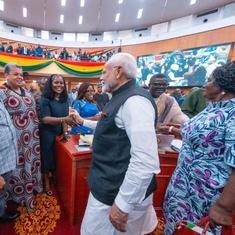There have also been occasions when musicians have taken on the role of the craftsmen. In recent times, the sundari, a lesser-known cousin of the northern Indian shehnai, was developed by the Jadhav family from Maharashtra. Though smaller and shriller than the shehnai, the sundari has been incorporated into the ever-increasing family of Indian instruments.
Presently, Bhimanna Jadhav is perhaps the best-known sundari player in the country. He talks about the sundari in this short film.
The taar shehnai is a deviation from the esraj, an instrument that combines features of the sitar and the dilruba. The esraj has a fret-board similar to that of the sitar and a sound-box resonator like that of the dilruba. As with the esraj, the taar shehnai is also a bowed instrument, but it has a horn that rests on the bridge giving the instrument its typical thin and sharp tonal quality. This horn is similar to the one used in a shehnai, which is how the instrument derives its name.
This clip features taar shehnai player Piara Singh speaking about his instrument and playing a folk tune in raag Pahadi.










